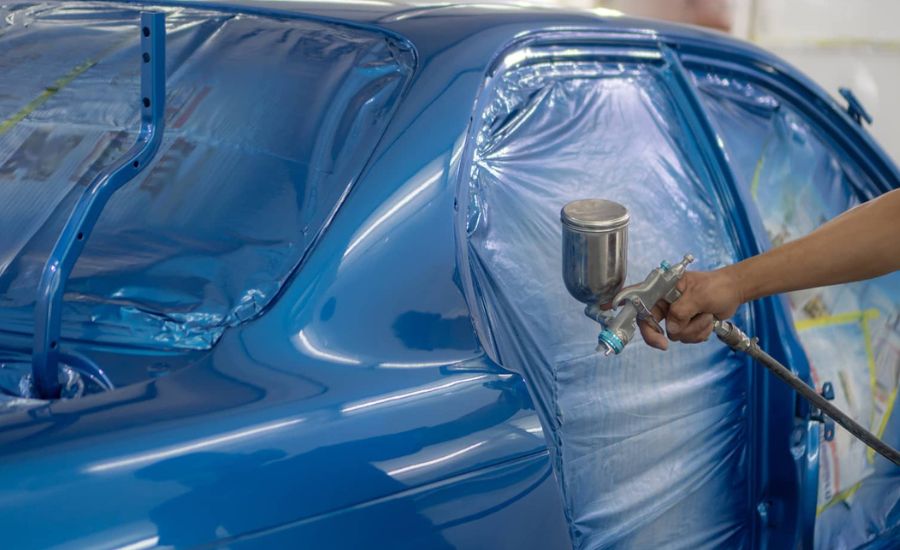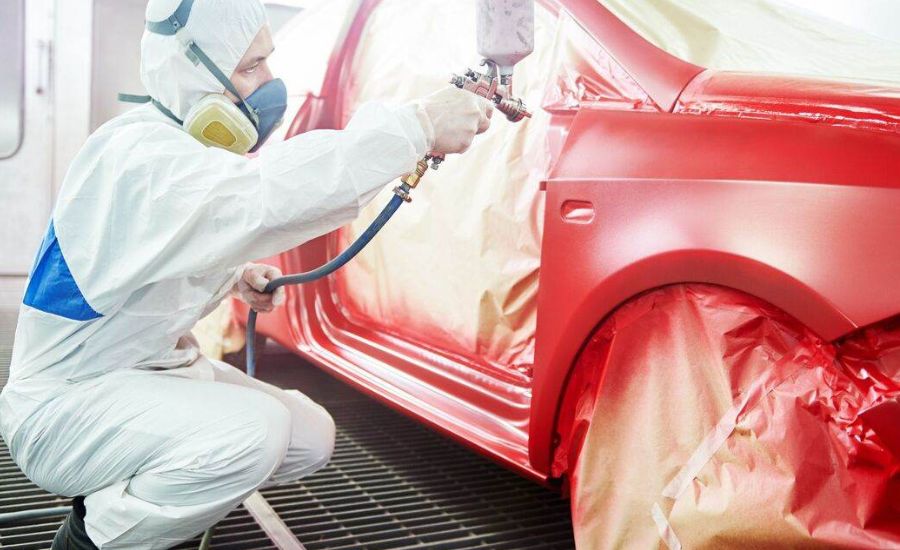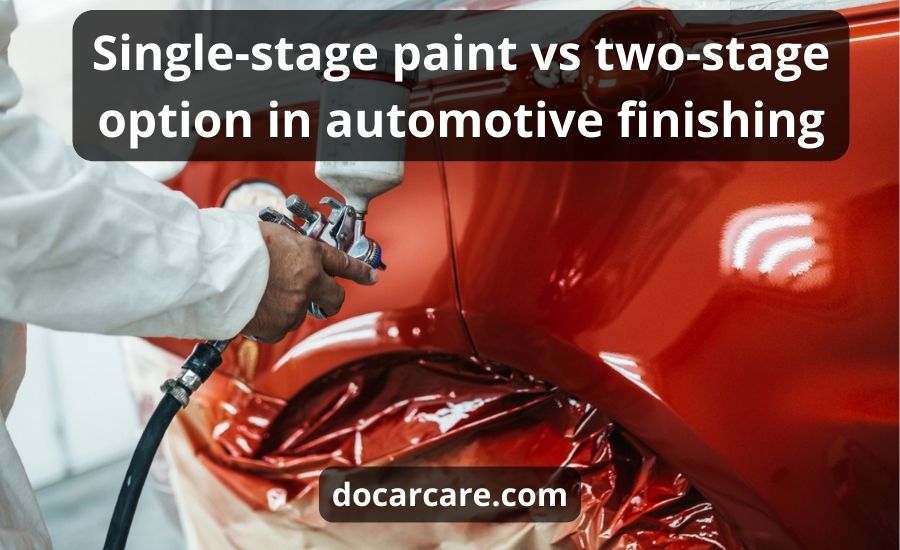Which the best Single stage paint vs Two stage? Debates about single-stage paint and two-stage paint methods have been frequent occasions among enthusiasts, professionals, and DIY car aficionados alike.
Each approach brings its own set of virtues and considerations to the paint booth, contributing to the final masterpiece that graces the car’s surface.
In this comprehensive exploration, we delve into the nuances of single-stage paint vs two-stage paint, dissecting these techniques and uncovering the key differences that shape the outcome of the paint job.

Single-stage paint and two-stage paint: basic info and the painting procedures
Let’s begin with basic facts about two distinct techniques to paint a vehicle.
Single-stage paint: the basics
Single-stage paint is a procedure renowned for its simplicity and efficiency. In single-stage painting, the entire process, from color application to protective coating, is condensed into one stage. The paint used in this approach typically contains color pigments, binders, and protective clear coats, all blended into one mixture of one-stage paint.
The process begins with surface preparation, involving the meticulous cleaning and smoothing of the car’s exterior (critical for orange peel prevention.) Wet sanding is often applied here. Once the canvas is ready, the single-stage paint implies a singular, complete step as a single-stage finish coat. However, the number of coats is up to you. You may opt for only one coat and two coats, too. Just don’t go overboard.
Two-stage paint: basic info
Two-stage paint presents two distinct acts. But first — cleaning and wet sanding the vehicle surface. If you don’t want to wet sand, you may use a dry sand technique. Then comes the base coat, which imparts the color to the car’s surface.
After you let the base coat dry, the second act commences with the clear coat paint.
The dual purpose of these clear coats is to enhance the color’s depth and act as a protective shield.
The two-stage overall paint job demands meticulous attention to detail during both the primer stage and the final stage.

Comparing single-stage vs two-stage paint
Now it’s time for the confrontation. We have chosen the criteria which will help you assess both methods.
Finish and depth
As a representative of easy consistency, single-stage paint, with its singular act of color application and clear coating, provides an impressive outcome. Single-stage paint secures the resulting uniformity in glossiness, offering a straightforward, all-encompassing sheen.
Single-stage coatings, being an integral part of the single-stage painting procedure, not only bestow a protective layer but also contribute to the perfect car surface.
The two-stage painting method unfolds as a synergy of multiple layers, each contributing to the depth of the final composition. Act one introduces the base coat. The second act takes over with the clear coat: a safeguard and a color intensity enhancer.
Durability
Single-stage paint secures a robust shield against the elements. The integrated clear coat offers a baseline level of the primary color layer protection accomplished in one stage.
However, it’s essential to underscore that the resilience of single-stage paint might be lower; the two-stage paint is supposed to be a more durable paint variant. The all-in-one application might not supply the same level of resilience as the multi-layered and more thorough nature of two-stage painting.
The allure of single-stage paint lies in its ease, and this characteristic is vividly reflected in the application process.
The painter begins with meticulous surface preparation, ensuring that the canvas is smooth and receptive to the forthcoming layers. The single-stage paint, a blended concoction of color pigments, binders, and clear coat components, is then skillfully applied in a singular act.
On the contrary, the two-stage paint unfolds as a two-act procedure. Act one involves the base coat, the foundational layer that imparts the chosen color to the vehicle’s surface.
After making sure the base coat has dried, the second act can be launched with the fresh clear coat.
The importance of this translucent layer is substantial: it demands a meticulous hand and serves as the primary protective shield.
The two-stage paint method introduces a dual-layer defense mechanism that elevates the durability quotient. The first act: is the base coat, and the second act: is the clear coat, which performs as a formidable guard.
Repair and touch-up
The integrated nature of the clear coat comes as a benefit in the single-stage paint. The homogeneity of the finish aids in seamlessly blending touch-up paint with the existing coat. Single-stage paint dries within an hour (on average), and you are ready for a touch-up.
However, achieving a truly seamless repair may require a skilled hand. The challenge lies in precisely matching the color and glossiness of the original finish.
The layered nature of two-stage paint introduces a more nuanced approach to repair and touch-up endeavors (relative to single-stage paints.) Being separate entities, the base coat and clear coat necessitate a more precise approach when addressing imperfections avoiding using too much paint.
The challenge lies in the potential for the repaired area to stand out if the color matching and clear coat application are not executed with precision. Too much material (paint) applied is another potential issue,

Cost factor
Single-stage paints are often viewed as a “value for money” option. The all-in-one application reduces the number of materials required and minimizes labor times. Enthusiasts looking for an efficient and economical way to glamour up your four-wheeled baby may confirm that single-stage painting is a more pragmatic fix in the single-stage vs two-stage paint competition.
The layered approach to painting cars performed by a two-stage paint job introduces additional materials and labor into the equation, contributing to a higher overall cost in comparison with its single-stage counterpart.
However, the financial commitment often comes with a payoff in terms of the outcome. Two-stage painting can accomplish extra depth, durability, and a broader range of aesthetic choices.
Choosing the right paint: navigating the palette of options
Selecting the ideal coating for your auto endeavor is a pivotal decision that can significantly impact the finished product. Here’s a guide to help you navigate the palette of options and opt for the absolute best: single-stage vs two-stage painting.
#1. Define your vision. Before diving into paint options, clarify your vision for the project. Consider the desired finish, color, and level of glossiness. Understanding your aesthetic preferences will guide you through the myriad choices available.
#2. Understand the basics. Familiarize yourself with the basic types of automotive paint. Single-stage paint includes the hue and clear coat in a one-for-all mode, while two-stage paint seems more complex with a base coat and a clear coat.
#3. Consider your skill level. Assess your proficiency in this area. Single-stage painting, with its streamlined process, might condone the beginners. Two-stage painting requires a meticulous hand with its layered approach; a higher level of precision is paramount here.
#4. Evaluate durability needs. Assess potential situations the vehicle may find itself in. If it will be exposed to harsh weather conditions or extensive outdoor use, prioritize paints with a higher level of resistance. Two-stage painting often provides enhanced protection.
#5. Factor in repair and maintenance. Consider the ease of maintenance and mending. Single-stage paint can pardon minor flaws, while a two-stage paint job may demand more precision. Evaluate how important ease of maintenance is for your project.
#6. Budget considerations. Make cost estimates for the endeavor. Single-stage painting secures a better deal, making it suitable for those mindful of expenses. Two-stage painting may involve a higher initial investment.
By considering the above factors you can navigate the diverse palette of paints available and transform your vehicle into a personalized work of art.

Conclusion
The preferred choice among single-stage and two-stage paints is a voyage through a palette of options, each stroke shaping the canvas of a vehicle’s identity. As we’ve explored these painting methods, it becomes evident that the decision is a fusion of artistry and practicality.
Single-stage painting, with its streamlined simplicity, offers a classic and uniform finish, making it an accessible choice for those seeking efficiency and elegance. Whereas two-stage painting introduces a layered brilliance, providing a broader spectrum of finishes and enhanced durability, albeit less budget-friendly.
The key here lies in understanding your vision, skill level, and project requirements.
FAQ
What’s better single stage or two stage paint?
Your priorities define the preference. Single-stage paint is straightforward and more cost-effective, while two-stage paint offers a broader assortment of finishes and extra resilience.
Why is single stage paint better?
Value for money and streamlined approach— that’s justification single-stage paint is sometimes considered better. It streamlines the painting procedure, making it more accessible.
How many coats of single stage paint should I use?
The sufficient amount doesn’t typically exceed one or two coats of single-stage paint. The exact number can depend on factors like the color, the condition of the surface, and the desired finish. Avoid thick paint layers as orange peel may become their unwanted consequence.
Does single stage paint scratch easily?
The scratch resistance of the single-stage paint isn’t impressive due to its lack of extra protection in the form of the clear coat layer. Whereas with two-stage paint, grazing is less likely. However, an additional contributing factor to predisposition to grazing may be the type of clear coat or its quality, to be precise.
What are the disadvantages of single stage paint?
Among the main flaws of single-stage paint are a lower level of resilience as opposed to the two-stage option, a high possibility of orange peel, and a higher susceptibility to scratches and environmental damage as a distinct clear coat layer is absent.
What is the difference between single stage and dual stage auto paint?
The distinction of single-stage versus two-stage (dual-stage) auto paint is the number of phases:
1. Single-stage paint: incorporates one act where the tone and clear coat are merged.
2. Two-stage paint: incorporates two separate phases – a base coat for the tone and a clear coat for safeguard and sheen.

